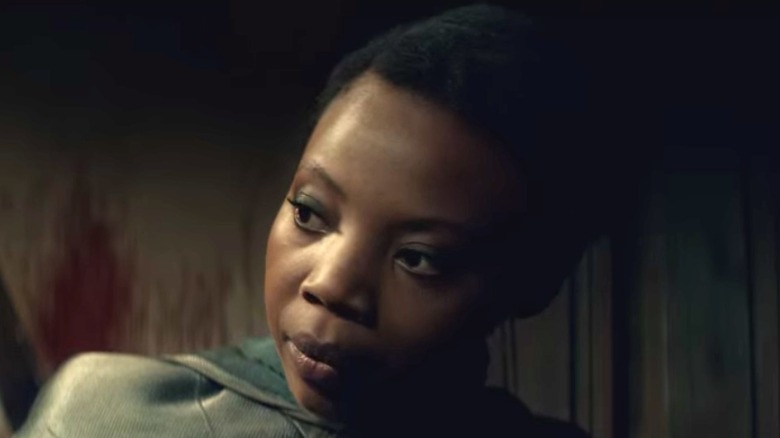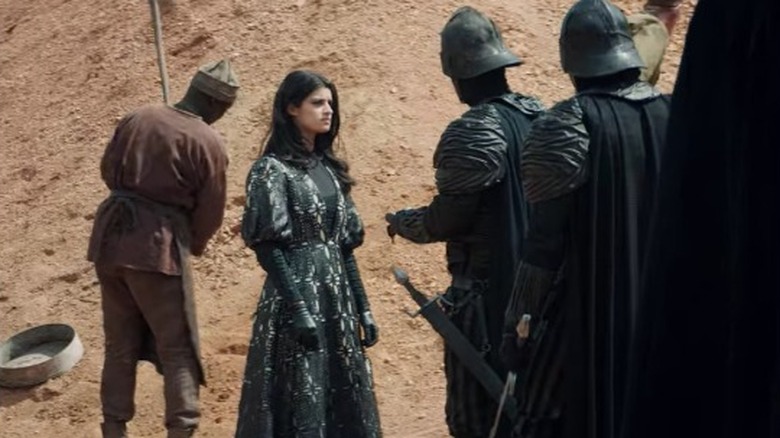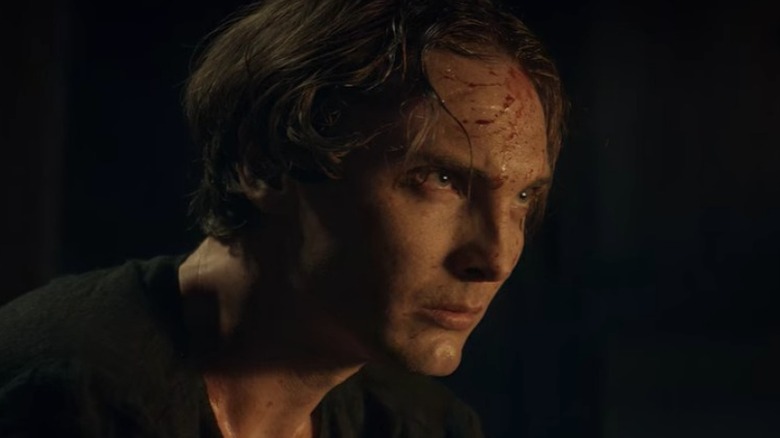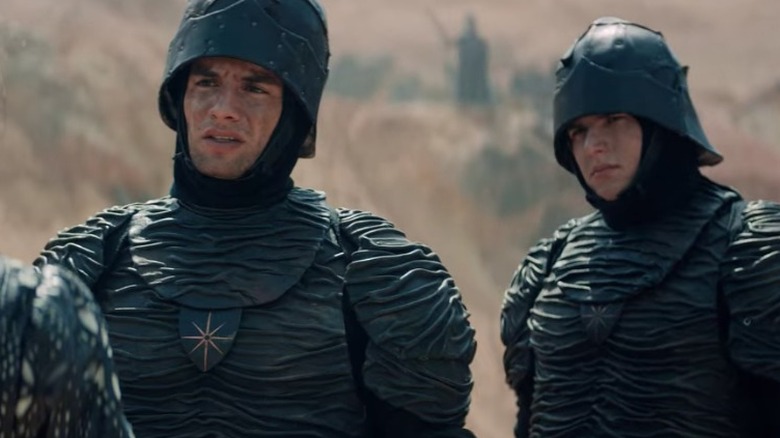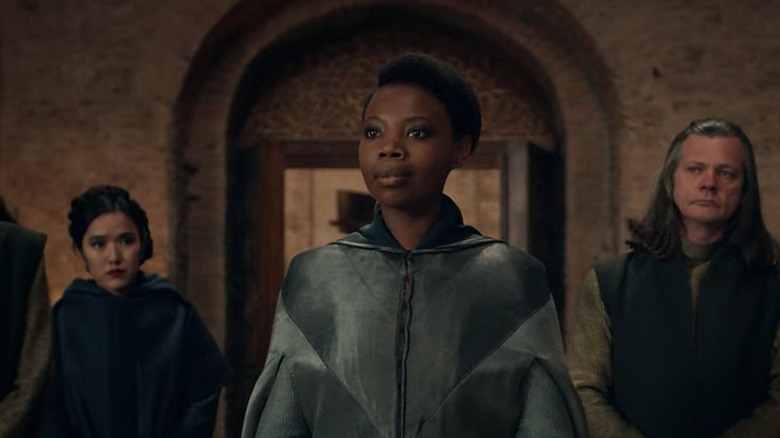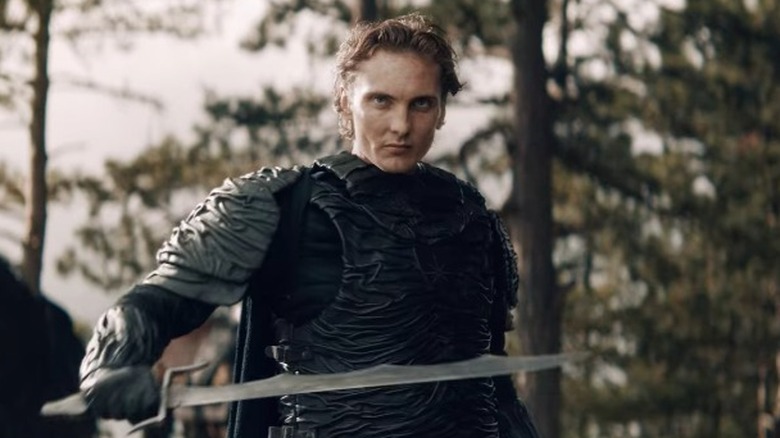The Untold Truth Of The Witcher's Nilfgaardian Empire
Contains minor spoilers for "The Witcher" Season 2
With the premiere of Season 2 of Lauren S. Hissrich's Netflix adaptation of Andrzej Sapkowski's "The Witcher" upon us, audiences are eagerly tuning in, with hopes of finding answers to some of their most burning questions from Season 1. For instance, what became of the relationship between Yennefer of Vengerberg (Anya Chalotra), Princess Cirilla/Ciri (Freya Allan), and Henry Cavill's white-haired anti-white knight, Geralt of Rivia? Moreover, what were the consequences of the Battle of Sodden Hill, and why exactly did Ciri appear to demonstrate powers beyond her control? Perhaps most importantly, how does Nilfgaard and its heretofore unseen emperor play into all of this, and why does the black-armored, formidable force to the south want so badly to get its hands on the series' young protagonist? Finally, why is Mimi Ndiweni's Fringilla so determined to ensure Nilfgaard's victory?
If the series' most foreboding military force has you intrigued, it's because Sapkowski's novels give it a history rich in lore, lineage, and a determined belief in forces and prophecies that the series, wisely, had yet to reveal by the close of Season 1. And although new and ever more complex revelations and insights with regard to the Nilfgaardian empire came in the 2nd season, there's still miles and miles of narrative thread to unwind.
Audiences shouldn't be so quick to compare Nilfgaard to any real-world empire
Viewers first introduced to Sapkowski's world via Hissrich's adaptation might be tempted to see Nilfgaard as a Communist force. All the signs, after all, are there. When Royce Pierreson's Istredd explains their invasion to Yennefer, he says, "these people were starving before Nilfgaard ... they look out for their people, everybody gets something," to which she replies, "the same thing." And when Fringilla is defending Nilfgaard's actions to the council, she certainly seems to be espousing an early form of Leninism. "We believe in shared sacrifice," she says, after pointing out that Nilfgaard has "strengthened trade" and "funded research."
In Season 2, she insists they're trying to house, clothe, and bring freedom to people. On the other hand, Nilgaard's actions at Sodden Hill look a whole lot like Germany's invasion of the western border of Poland at the onset of World War II (via Britannica). Then there are the many elements Nilfgaard shares with ancient Rome: both were inconsequential republics in the south before growing into an unstoppable empire determined to conquer the world and assimilate its various populations.
But it's a mistake to attempt a superimposition of specific real-world conflict onto the complex world of "The Witcher," partially because it ignores what Sapkowski himself has said of his work — namely, as he notes in "Historia i fantastyka," that it's "a pseudo-world, a mere background," and "subservient to the plot" — and partially because it limits the underlying lesson we might glean from it. That is, that as long as there are sentient beings living within close proximity to one another, there will be conflict.
Ithlinne's prophecy looms large in Nilfgaard
Although we get a taste of the ancient elf Ithlinne's ominous prophecy in Season 1 of "The Witcher," its connection to the motivations of Nilfgaard wasn't yet made clear, and intentionally so. As Season 2 delves deeper into both the second and third novels — "Blood of Elves" and "The Time of Contempt," respectively — we begin to learn quite a bit more about how the prophecy controls the actions of the impending empire to the south.
Ithlinne's prophecy is introduced in full at the start of "Blood of Elves," and although its meaning is intentionally obscure and open to interpretation, it's clearly a foretelling of the end of the world and the start of a new one. "The era of the sword and axe is nigh," it reads, "the Time of the White Chill and the White Light ... the Time of Madness and the Time of Contempt ... the Time of End. The world will die amidst frost and be reborn with the new sun. It will be reborn of Elder Blood, of ... A seed which will not sprout but burst into flame ... first the earth will flow with the blood of Aen Seidhe, the Blood of Elves..."
For Nilfgaard, the prophecy is no mere ghost story. What appears (again, intentionally) like a kind of religious fervor in Season 1 is really more like a steadfast belief in a particular interpretation of Ithlinne's prophecy. The ruler of Nilfgaard — the "White Flame" who reclaims his throne from The Usurper in Season 1, but whom we never see — is intent on finding Ciri because he believes she holds the key to the "seed" mentioned in the prophecy. Without making too many assumptions about how Hissrich will follow/relay "The Witcher" source material, savvy viewers would be wise to pay attention to Ciri's immediate (and not so immediate) lineage.
Nilfgaardians speak a dialect of The Elder Speech
Speaking of The Elders, Nilfgaard's connection to the ancient Elven civilizations is perhaps most apparent in their language — a dialect of The Elder Speech, aka "the language of the elves," as we learn in "Sword of Destiny" (p. 216). Nilfgaard is an extraordinarily old southern kingdom whose first human inhabitants co-mingled with elves known as the "Black Siedhe," and whose people can therefore trace their roots and bloodlines back to them (via CBR). In creating The Elder speech and its various dialects, Sapkowski drew heavily from Welsh, the Irish language, and Scottish Gaelic — commonly grouped together under the term "Celtic" — with a dash of German, Latin and various other languages (both Romantic and Germanic) sprinkled in.
The elven word for humans, for example, "Dh'oine," closely resembles both the Irish and Scottish Gaelic terms for "human" or "people" (via Oxford Reference), while the word for elf, "Siedhe," resembles the Irish term for fairies, "sídhe" (via Collins Dictionary). Although the Nilgaardian language is only a dialect of the Elder Speech, it nonetheless reveals the truth behind their centuries-old connection to the non-human race thanks to its many similarities. For example, the Nilfgaardian word for "hope" is dòchas, the same word used (with varying accents) in both Irish and Scottish Gaelic (via Word Sense).
For the Netflix adaptation, Hissrich hired David J. Peterson — the man behind the Dothraki and Valyrian languages used in HBO's own adaptation of "Game of Thrones" — to fully flesh out Sapkowski's creation (via IGN). In addition to the language helping to create a more realistic and fully-immersive world, it intricately connects the Nilfgaardian humans to the elves — a connection that hints at both their obsession with Ithlinne's prophecy and helps to explain the relationship they develop with the elves in Season 2.
Nilfgaard isn't the true antagonist in The Witcher
With their dark and foreboding armor, their seemingly insatiable need to conquer everything in their path, and their "no quarter given" policy on the battlefield, it's easy to see Nilfgaard as The Continent's most menacing villain. But as Sapkowski's story slowly unfolds over the course of his novels, it becomes clear that Nilfgaard isn't the "bad guy" so much as it is symptomatic of the true force of evil with regard to the world. We caught a glimpse of this in Season 1, in both Fringilla's and Istredd's defense of Nilfgaard's actions, as well as in the somewhat mysterious portrayal of Nilfgaard's infamous Black Knight (Eamon Farren). In Spakowski's "The Time of Contempt," however, it's the powerful (but neutral) mage Tissaia de Vries (MyAnna Buring) who most clearly points out the hypocrisy in treating the Nilfgaardians as one-dimensional villains.
Without giving too much away for anyone reading the books along with the series, Tissaia scolds a group of members of The Brotherhood and The Chapter for their treatment of various other members who've chosen to secretly side with Nilfgaard. The rectoress of Aretuza points out that the Northern kings — against whom Nilfgaard is waging war, and to whom the Nilfgaard-hating mages are bound — have been exterminating "elves and other non-humans," and also "want to unleash war." She tells the indignant group who've turned on their brothers and sisters (whom they see as "traitors" for working with Nilfgaard) that they've merely "sold out to kings, rather than to Nilfgaard.
Nilfgaard, she suggests, is no different than the northern kingdoms: both sides employ the guise of a "just cause" to condone their violent power grabs. The conversation is one of many like it in the novels that reveals The Continent's true antagonist — that is, the blind faith in, and subsequent loyalty to, a cause that allows humans and non-humans alike to justify war, vengeance, and the shedding of innocent blood.
There's a reason Vilgefortz didn't succeed in killing Nilfgaard's Black Knight
In "The Witcher" Season 1 finale, audiences are treated to an epic sword fight between mage and former mercenary/general Vilgefortz (Mahesh Jadu) and the face of the Nilfgaardian war machine, Cahir (aka the Black Knight). Cahir ultimately defeats but fails to kill the ostensibly battle-weary Vilgefortz, who is knocked unconscious for a while after Cahir kicks him down a steep hill. Something about the scene doesn't quite make sense, though, and there's a very good reason for that. We know, for instance, that although Vilgefortz appears to be in his 30s, he is, like most mages, actually much, much older. We also know that he's led soldiers into battle numerous times. So with all his extra years of experience on the battlefield and his ability to strategically conjure chaos, how is it that a mere human from Nilfgaard is able to so swiftly defeat the skilled swordsman and mage?
A closer look at the combat scene reveals Vilgefortz isn't quite giving it his all. There are at least a handful of chances wherein he appears to have the upper hand on Cahir, but somehow quickly loses it after a blink-and-you'll-miss-it pause. Yennefer assumes he's simply not using his reserves of chaos wisely, but that seems unlikely given all we know about him. The reality is that Vilgefortz can't kill Cahir, because he's too important to the Nilfgaardian cause. If you've not yet read the books or played the game, and are wondering why in the world Vilgefortz would care about assisting Nilfgaard, his ulterior motives could well be revealed in Season 2, just as they were hinted at in his final scene of Season 1, wherein he beats a soldier from his "own side" to death.
